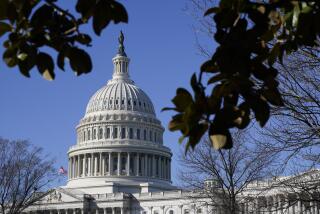Why old-fashioned TV is still the winning ticket for political ads

Anyone who has followed the fate of the TV business in recent years could not be blamed for thinking the medium is dying.
Consumers have been shifting away from traditional or linear TV viewing that is watched in real time to streaming video, where they can watch what they want on demand. In 2023, streaming surpassed broadcast and cable TV viewing for the first time, according to Nielsen.
But in the current presidential election cycle of 2024, the mantra is — long live TV.
Political advertising is a regular shot of adrenaline for the TV business every two years when House and Senate seats are in play. The dose is even more potent when the White House is on the line. Even as audiences decline, TV is expected to see a record haul in 2024 as a contentious presidential primary and general election — plus 435 congressional seats, 33 U.S. Senate races and 14 statewide gubernatorial contests — will drive political advertising expenditures across all platforms to $17 billion, according to media investment agency GroupM.
The figure is an increase of 31% over what was spent in the 2020 presidential election year and 24% over the previous high of $12.8 billion spent in 2022, according to GroupM’s data.
“Local TV is going to see the vast majority of that,” said Kate Scott-Dawkins, global president of business intelligence at GroupM. One TV executive estimated that local stations could see between $8 billion and $9 billion from political commercials.
It’s why major station owners such as Nexstar, Fox Corporation, Scripps and Paramount Global are predicting a financial windfall, especially in markets located in the swing states up for grabs in the presidential campaign. California will be seeing spots early and often as Democrats vie for their party’s nomination to run for the U.S. Senate seat formerly held by the late Dianne Feinstein.
After the success of their recent meetings, Sean Hannity invites California Gov. Gavin Newsom to debate Florida Gov. Ron DeSantis on his Fox News show.
Cable news networks, which devote the bulk of their coverage to politics, stand to see gains as well from national campaigns and issue advertising by advocacy groups and political action committees.
The polarized political climate is a factor in escalating spending. Referendums on abortion rights are expected to be on the ballot in several states. The last such vote, held in Ohio in November, led to $70 million in ad spending by groups representing both sides of the issue.
While most members of Congress are in safe districts and don’t have to spend heavily on advertising, a growing number of incumbents on the extreme left or right are facing challenges where more moderate candidates are being put up against them.
“Historically you only saw significant primary money in an open seat,” said Patrick Paolini, executive vice president for ad sales at Fox Television Stations. “Now we’re seeing it when the seat is filled with an incumbent who is actually going to still run. That’s part of the changing landscape in where this money is coming from.”
While streaming is siphoning off viewers, local TV is still considered easier and more efficient to buy for a campaign that wants to spread a message quickly. While overall ratings have been in steady decline, broadcast TV still has high-rated live sports events such as the NFL, where every game is shown on local TV in the markets of the teams, playing even in match-ups that are shown nationally on streaming or cable.
“Regardless of any kind of audience decline, TV is still the best way to reach the masses in a short amount of time,” said Robert Breen, co-head of sales and operations for CBS Television Stations.
Television stations also may be benefiting from political consulting firms and campaigns being slow to adapt to streaming.
“There is a certain amount of ‘This is what we’ve done in the past, we know it works and we’re going to do it again,’” said Scott-Dawkins.
Streaming services such as Netflix, Hulu, Disney+ and Amazon — which all now have ad-supported tiers — are expected to get a greater share of political dollars in this campaign cycle, according to GroupM. Ondine Fortune, a veteran political ad buyer based in Redondo Beach, noted that the spending is still not commensurate with the number of viewers that streaming delivers.
“When I get a new client, I have to put them through a whole learning process,” Fortune said. “They are not putting in the dollars they should be on streaming. They don’t believe in it. It’s like how cable was in the early days.”
Fortune believes more political ad money will shift to streaming as a younger generation of political operatives comes online.
But for now, traditional TV will continue to benefit from one of its key advantages — local newscasts, which will be saturated with political ads in markets with competitive races.
After the success of their recent meetings, Sean Hannity invites California Gov. Gavin Newsom to debate Florida Gov. Ron DeSantis on his Fox News show.
Campaigns favor running their spots in local newscasts because they are watched by viewers who are politically engaged and more likely to go out and vote. They tend to be older and more likely to watch traditional TV than younger consumers.
The local news environment appeals to campaigns as well. Surveys by the Knight Foundation have found that Americans trust local news more than national news sources by a 2-to-1 margin, with TV stations being their primary news source.
As viewers have gone to streaming for scripted dramas, sitcoms and movies, TV stations have added more live local newscasts to their lineups.
A survey by the Radio Television Digital News Assn. and Newhouse School at Syracuse University found that TV stations were airing 6.6 hours of news each weekday in 2022, up from 5.7 hours in 2022.
Unlike network and syndicated programming, stations get all of the commercials and ad revenue in those hours. Fox’s station group churns out a combined 1,200 hours of local news a week.
While the generally nonpartisan approach of local TV news is a selling point to campaigns, some also want to reach the tribal political junkies who watch cable news as well. Campaigns for president, U.S. Senate and governor will make national buys on cable news to raise their profile and stimulate campaign contributions.
Even though much of the programming on conservative-leaning Fox News is not hospitable to liberal viewpoints, the most-watched cable network has a large number of Democrats and independents tuning in, and campaigns want to reach them. In 2020, President Biden’s campaign made a multimillion-dollar commercial buy on Fox News, including during the network’s coverage of the Republican National Convention.
“Candidates have taken notice of that,” said Jeff Collins, executive vice president of ad sales for Fox News. “We’ve seen them come out and want to be in high-rated programming to get their message in front of an engaged audience that cares about politics.”
Fox News and CNN saw declines from last year while MSNBC saw a slight gain. The networks still face an existential threat from cable cord-cutting.
Collins added that his network is open for business to all parties and points of view, with few restrictions on where their spots run.
One of the commercials that ran during last week’s Fox News town hall with former President Trump — watched by 4.5 million viewers — was purchased by Republican Accountability, a political action committee opposed to Trump.
The ad used footage showing the violence at the Jan. 6 insurrection with the message “He can never be president again.”
More to Read
Inside the business of entertainment
The Wide Shot brings you news, analysis and insights on everything from streaming wars to production — and what it all means for the future.
You may occasionally receive promotional content from the Los Angeles Times.









